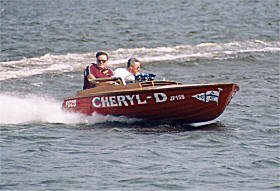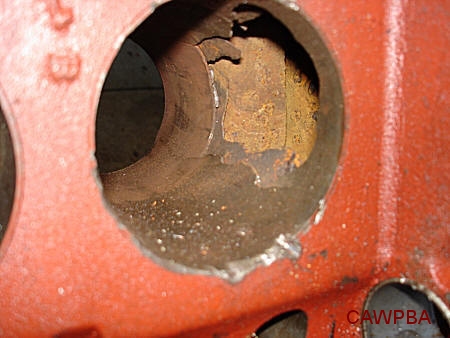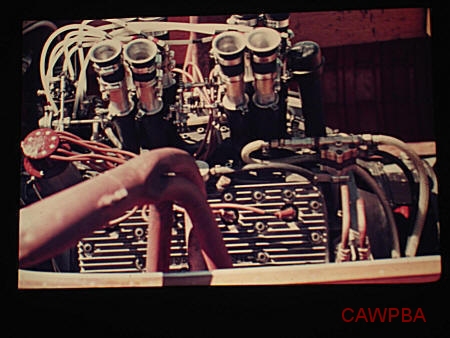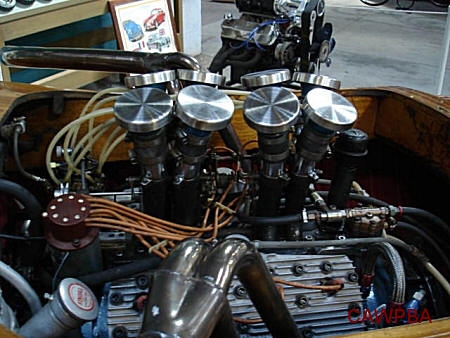Cheryl D is a Lewis skiff acquired by Paul Siddall from Bill Dudley. The skiff is a 1948 Lewis and was very successfully campaigned in Victoria and mostly at Paynesville in the sixties and early seventies. It holds a number of championships including the 1974 266 Class.
Changes in Bill’s life meant the boat sat in Bill’s shed for many years until it was tracked down by Paul. The engine was in pieces as it was Bill’s practice to dismantle the engine at the end of each race season ready for the next. The engine was never rebuilt and CD didn’t see water again for over 25 years.
Unfortunately Paul's engine builder struggled with the highly modified flathead Ford. The refreshed engine unfortunately stuck a leg through the block in grand style. The historic engine was damaged beyond repair with holes in places there shouldn’t have been holes. Paul decided he had had enough.
Paul Siddall and mate in CD
Steve Young took over CD from Paul. “I worked on this boat in my mid-twenties and drove it on a couple of occasions. I have a long association with Bill and CD and when I became aware she was for sale, I had no choice. Bill taught me a lot about engine building and I had always dreamed of owning the boat . . . and in particular, that engine”.
Steve finally got the boat back to Sydney and began work. With an almost immediate request to show the boat in the Gippsland Vehicle Collection in Maffra, Steve dressed up the broken engine for display. CD sat there for three months.
Hole through the cylinder wall
Hole where the number one rod punched through
the camshaft and into the water gallery
This gave Steve time to find another block and to start the reconstruction of that remarkable engine. “I found a good block in Wangaratta and using the old one as a template started the many hours of machining and grinding to recreate the engine. Bill had included many little tricks to dramatically improve engine breathing to extract well over 220hp from the normally lazy 100hp of the original flat head.”
A new cam has been ground using the bits of the old cam to get the right profile and the fuel injection system has been rebuilt. The electric fuel boost pump was seized from being immersed in water. “The electric fuel pump is essential. Unless you have fuel pressure at 106 psi, the engine is a dog to start – if it starts at all. Once the engine is running, the mechanical pump provides the pressure, but until the mechanical pump builds sufficient pressure, that electric pump is essential.”
CD's engine when Steve worked on it many years before
The whole fuel system has been stripped and rebuilt up to the point of testing the injectors and the distributor pump. This requires a test rig which Steve is building. In fact, the fuel system is from one of Jack Brabham’s very successful F1 cars. “I ran across a guy who campaigns one of Jack’s cars at historic events. He nearly wet himself when he saw the fuel injection system and what it was on. I have no idea how Bill came to have it on a side valve but the guy wanted to buy it there and then for his car!”
The starter motor, mounted on the end of the crank, also suffered from being dunked and has been rebuilt. The starter reduction gearbox is from an aircraft engine and Bill grafted a Willys starter motor to it. The V drive gearbox had also suffered. “Bill made the gearbox from a couple of blower ends. Many V-drive gearboxes run cooling and scream like hell, but this one runs ATF, is quiet, and has no cooling at all. I can remember Bill going flat out and winning 10 mile races at Paynesville and the gearbox was still cool enough to touch when he came in. Thankfully there was minimal damage to the gearbox and with new bearings and the right lubricant, it should be fine.”
Getting the new crank balanced was a trick because the engine doesn’t run a flywheel, so the crank balance needs to be spot on and cannot be compensated for by using the flywheel. “The engine shop kept asking me for the flywheel so they could do the balance”.
There is a still plenty to do including some minor hull work but, if work commitments allow, Steve’s plan was to have CD back on the water for the summer. After a few runs to bed in the engine and settle everything down, Steve wants to have a go at the 266 cubic inch side valve measured mile. “It was always Bill’s intention to have the fastest boat in the class but the last time he tried at Paynesville he missed by 0.4mph. Perhaps I can do it for him.”





